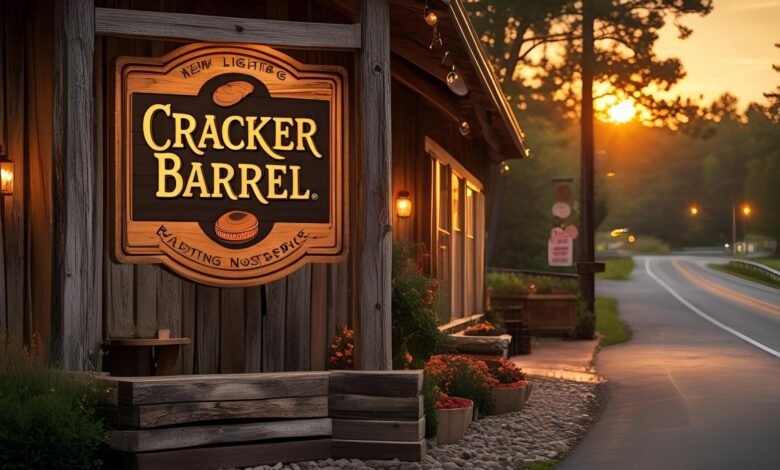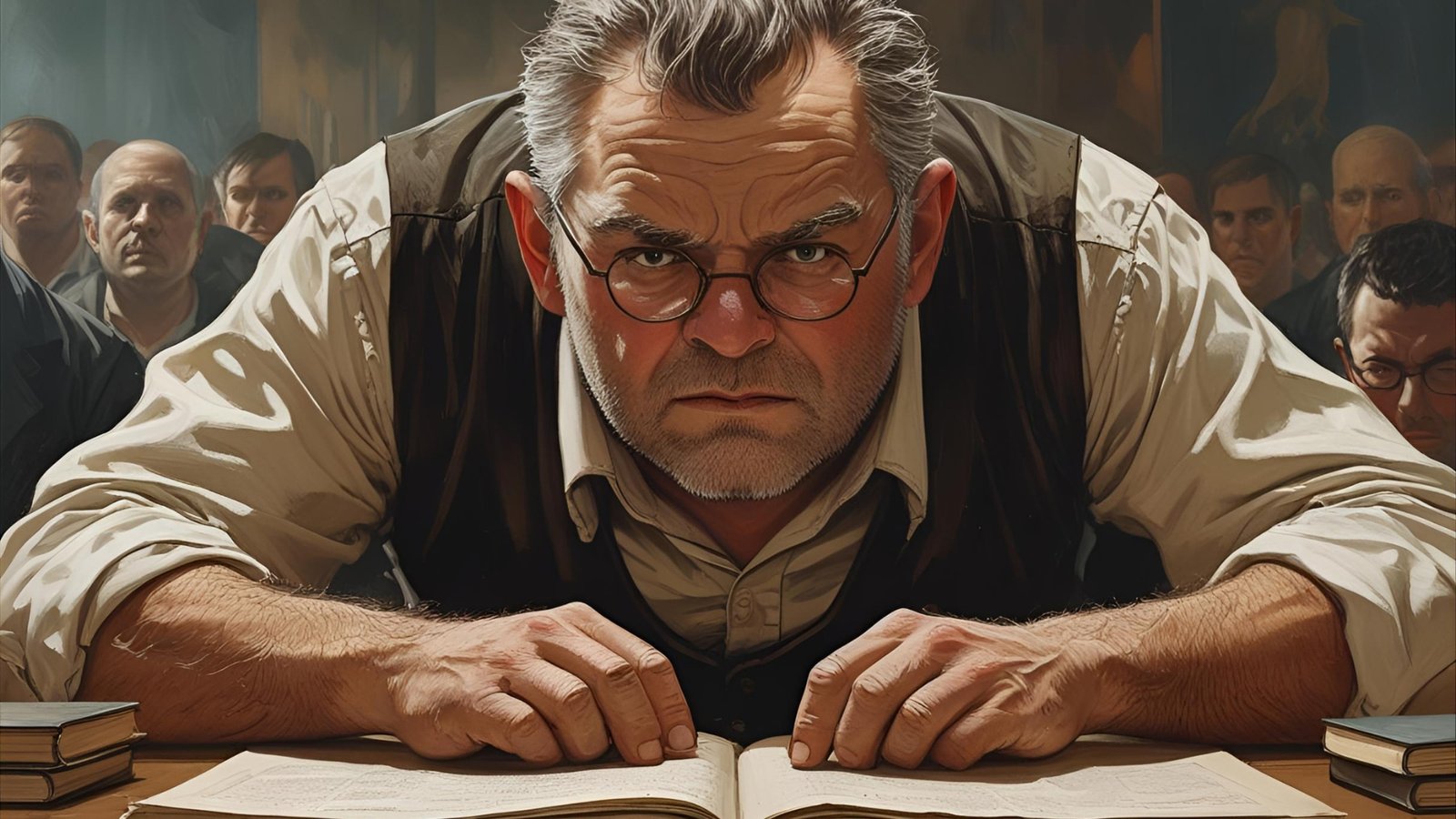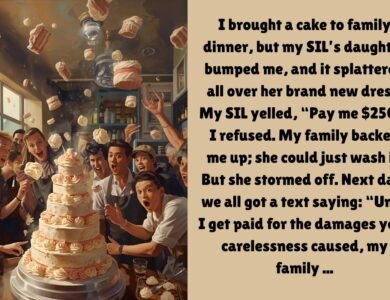
The restaurant industry witnessed an unprecedented upheaval this week when Cracker Barrel, America’s beloved southern comfort food chain, unveiled its first logo change in nearly five decades. What was intended as a modern refresh has instead become one of the most polarizing corporate rebranding decisions in recent memory, sparking fierce debates across social media platforms, financial markets, and dining rooms nationwide.
Cracker Barrel’s new logo represents far more than a simple aesthetic update—it symbolizes a fundamental shift in the company’s identity that has left customers, investors, and industry experts questioning whether the iconic chain has abandoned its roots in pursuit of modern relevance. The removal of the traditional man-on-barrel imagery has triggered reactions ranging from nostalgic disappointment to outright boycott threats, while simultaneously causing the company’s stock to plummet dramatically.
This comprehensive analysis explores seven crucial facts surrounding the Cracker Barrel logo controversy, examining the financial implications, customer reactions, design rationale, and broader industry context that make this rebrand a defining moment for the 53-year-old restaurant empire. Understanding these key elements provides essential insight into how heritage brands navigate the challenging balance between tradition and modernization in today’s rapidly evolving marketplace.
1. The Historic Logo Change: From Heritage to Minimalism
The Original Design’s 48-Year Journey
Cracker Barrel’s original logo, featuring a silhouetted figure of a man in overalls leaning against a wooden barrel, has been the company’s visual cornerstone since 1977. This iconic imagery perfectly encapsulated the restaurant chain’s commitment to old-fashioned hospitality, country store atmosphere, and traditional American values that resonated deeply with its core customer base.
The barrel logo design wasn’t merely decorative—it represented the authentic country store experience where communities would gather around barrels to share stories, conduct business, and build relationships. This symbolism became integral to Cracker Barrel’s brand identity, differentiating it from competitors and creating an emotional connection with customers seeking genuine, unhurried dining experiences.
The New Simplified Approach
The new Cracker Barrel logo strips away all traditional imagery, presenting only the company name in clean, modern typography. This dramatic simplification aligns with contemporary design trends favoring minimalism but has been criticized as generic and corporate. The logo redesign eliminates the rustic charm that made Cracker Barrel instantly recognizable, potentially alienating longtime customers who viewed the imagery as sacred.
Corporate rebranding experts note that this type of radical departure from established visual identity carries significant risks, particularly for heritage brands whose customers value consistency and tradition. The decision reflects broader industry pressures to appear contemporary and accessible to younger demographics, though the execution has proven controversial.
2. Market Meltdown: Stock Price Catastrophe and Financial Impact
Immediate Market Response
The Cracker Barrel stock price experienced a devastating collapse following the logo announcement, with shares plummeting as much as 15% in a single trading session. This dramatic decline wiped out approximately $100-200 million in market capitalization, demonstrating the profound financial consequences of poorly received corporate rebranding initiatives.
Financial analysts were caught off guard by the severity of the market reaction, with many noting that logo changes typically don’t trigger such significant stock volatility. The Cracker Barrel shares decline reflects broader investor concerns about the company’s strategic direction and its ability to maintain customer loyalty during this transition period.
Trading Volume Surge
The controversy generated unprecedented trading activity, with nearly four million Cracker Barrel shares changing hands—substantially higher than typical daily volumes. This surge indicates widespread investor uncertainty about the rebranding strategy and its potential impact on future earnings. The stock recovered partially by market close but remained significantly lower than pre-announcement levels.
Wall Street experts suggest the market reaction reflects concerns about potential customer defection, reduced brand recognition, and the substantial costs associated with implementing the brand transformation across 660+ restaurant locations nationwide.
3. Social Media Eruption: Customer Outrage Goes Viral
Widespread Backlash Intensity
Social media platforms exploded with criticism immediately following the Cracker Barrel logo reveal, with customers expressing feelings of betrayal, disappointment, and confusion. The hashtag movements and viral posts demonstrate the depth of emotional attachment customers had to the traditional imagery, with many describing the change as “brand suicide” and “corporate betrayal.”

Customer reactions ranged from nostalgic reminiscence about family dining experiences to threats of permanent boycotts. The social media backlash highlighted how deeply the original logo was woven into customers’ personal memories and family traditions, making the change feel like an attack on their cultural identity rather than a simple design update.
Conservative Political Undertones
The controversy took on unexpected political dimensions, with some conservative commentators framing the logo change as another example of corporations abandoning traditional American values. This political polarization has amplified the backlash beyond typical customer complaints, creating a cultural battleground that extends far beyond restaurant preferences.
Brand reputation specialists warn that when corporate decisions become political flashpoints, companies risk alienating customers regardless of their actual political positions. The Cracker Barrel controversy demonstrates how seemingly neutral business decisions can become lightning rods for broader cultural tensions.
4. The $700 Million Transformation Strategy Behind the Logo
Comprehensive Modernization Initiative
The new logo represents just one element of Cracker Barrel’s ambitious $700 million transformation plan designed to modernize the entire customer experience. This comprehensive initiative includes restaurant interior redesigns, menu updates, new technology integration, and updated marketing campaigns aimed at attracting younger demographics while retaining core customers.
CEO Julie Felss Masino has championed this modernization effort as essential for the company’s long-term survival in an increasingly competitive restaurant landscape. The brand transformation seeks to address declining customer traffic, evolving dining preferences, and the need to remain relevant to millennial and Gen Z consumers who value modern aesthetics and convenience.
Multi-Platform Integration
The logo redesign facilitates better integration across digital platforms, mobile applications, and social media channels where the simplified design performs better than complex imagery. This technical consideration reflects modern branding requirements that prioritize scalability and clarity across diverse media formats.
However, critics argue that technical optimization shouldn’t override brand heritage, suggesting that Cracker Barrel could have achieved digital compatibility while preserving traditional elements that customers cherish.
5. Industry Expert Analysis: Rebranding Success vs. Failure Factors
Heritage Brand Challenges
Restaurant industry analysts identify several critical factors that determine rebranding success for heritage brands. Successful transitions typically maintain core brand elements while updating peripheral aspects, whereas radical departures like Cracker Barrel’s logo change risk alienating loyal customers who view the brand as culturally significant.
Brand management experts cite successful heritage brand updates like McDonald’s golden arches evolution, which maintained iconic elements while modernizing aesthetics. In contrast, dramatic changes that eliminate beloved imagery often trigger customer rebellion and negative publicity that can persist for years.
Consumer Psychology Considerations
Marketing psychology research reveals that customers develop deep emotional attachments to familiar logos, especially those associated with positive family experiences and cultural identity. The Cracker Barrel logo represented more than corporate branding—it symbolized authentic American dining culture, making its removal feel like cultural erasure to many customers.
Consumer behavior studies suggest that heritage brands must navigate rebranding with extreme care, involving customer feedback in design processes and implementing changes gradually to minimize shock and resistance.
6. Customer Demographics: Generational Divide in Reception
Traditional Customer Base Response
Cracker Barrel’s core demographic—primarily older, rural, and culturally conservative customers—has responded overwhelmingly negatively to the logo change. These customers value tradition, authenticity, and consistency, viewing the modernization as abandonment of the values that originally attracted them to the brand.
Focus group research indicates that longtime customers feel betrayed by the rebranding decision, with many expressing plans to reduce visit frequency or switch to competitors that better preserve traditional dining atmospheres. This demographic represents Cracker Barrel’s most loyal and profitable customer segment, making their alienation particularly concerning for future revenue.
Younger Demographics Reception

Early indicators suggest that younger demographics have shown mixed reactions to the new logo, with some appreciating the modern aesthetic while others feel the change eliminates the rustic charm that made Cracker Barrel unique among restaurant chains. Millennial and Gen Z consumers often value authenticity and heritage, making the elimination of traditional imagery potentially counterproductive.
Market research firms note that attracting younger customers through logo changes alone rarely succeeds without corresponding improvements in food quality, service speed, and digital experience—areas where Cracker Barrel continues to face competitive challenges.
7. Future Implications: Long-term Brand Impact and Recovery Strategies
Potential Recovery Scenarios
Corporate crisis management experts suggest several potential paths forward for Cracker Barrel following the logo controversy. Options include partial restoration of traditional elements, enhanced communication about brand heritage preservation, or doubling down on modernization while improving customer engagement around the changes.
Brand restoration strategies often involve acknowledging customer concerns while explaining the rationale behind changes, demonstrating how core values remain unchanged despite visual updates. Cracker Barrel’s success in managing this crisis will likely determine whether the rebranding ultimately enhances or damages long-term brand equity.
Industry Precedent Setting
The Cracker Barrel logo controversy may establish important precedents for how heritage brands approach modernization in an era of rapid cultural and technological change. The severity of the backlash sends clear signals to other traditional brands about the risks of dramatic rebranding without adequate customer consultation.
Restaurant industry observers predict that Cracker Barrel’s experience will influence future heritage brand strategies, potentially leading to more conservative approaches to visual identity changes and greater emphasis on customer involvement in rebranding processes.
Conclusion
The Cracker Barrel logo controversy represents a watershed moment in corporate rebranding history, demonstrating the profound risks heritage brands face when attempting to modernize their visual identities. The dramatic stock price decline, widespread customer backlash, and intense social media criticism illustrate how deeply customers can connect with traditional brand imagery and the severe consequences of underestimating these emotional attachments.
Cracker Barrel’s new logo may ultimately succeed in attracting younger demographics and improving digital platform performance, but the immediate aftermath suggests significant challenges ahead. The company’s ability to navigate this crisis while preserving customer relationships and financial performance will provide valuable lessons for other heritage brands considering similar transformations.
Also Read: The Wedding That Never Was







